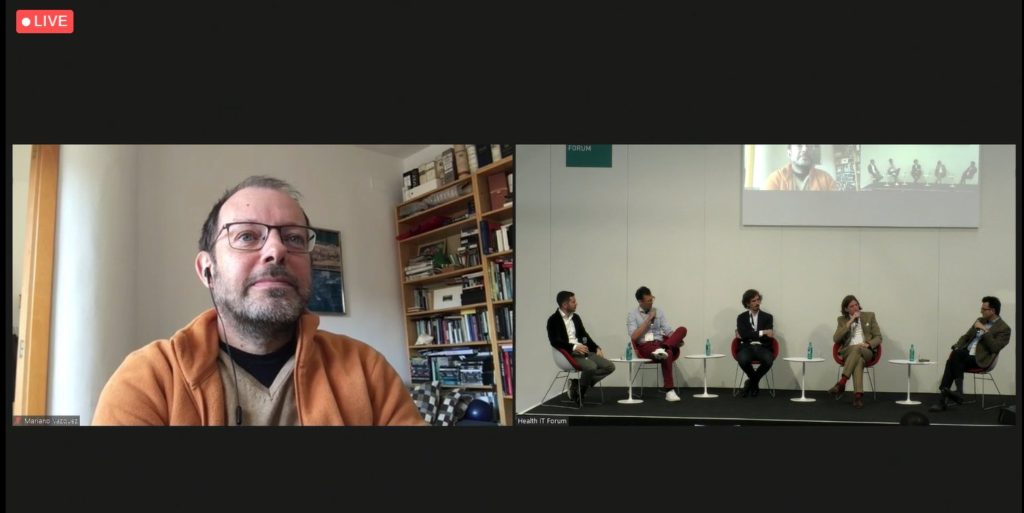
Last November, PerMedCoE Mariano Vázquez from Barcelona Supercomputing Center (BSC), participated in the MEDICA Health IT Forum as part of the invited expert panel, in the conversation entitled Biomedical platforms. The panel counted with the presence of numerous medical IT experts from the fields of data mining, imaging, artificial intelligence, data sharing and robotics (Healex GmbH, Decentriq, LynxCare and BSC).
MEDICA Health IT Forum is the platform that holds expert panels, tech talks and deep dive sessions about a topic. In 2021, the main topic has been innovations in digital health solutions. MEDICA is the world’s largest medical trade fair for medical technology, electromedical equipment, laboratory equipment, diagnostics and pharmaceuticals. The fair takes place once a year in Düsseldorf.
Mariano Vazquez is an established researcher at the Barcelona Supercomputing Center (BSC), and leads a multidisciplinary team with mathematicians, physicists, informaticians and engineers. He is also the cofounder, CTO and CSO of ELEM Biotech, a startup that spun off from BSC in 2018, that accelerates the technology transfer from research to the biomedical sector.
Hi, Mariano and thank you for joining us. Can you briefly tell us about your participation at MEDICA Health IT Forum?
Hi, thank you for having me.
I was one of the invited scientists to the discussion about Biomedical platforms in representation of the two Centers of Excellence (CoE), PerMedCoE and CompBioMed. My contribution served mainly to present both CoEs and raise awareness about the importance of finding a common language between clinicians and IT researchers, so we can find IT solutions to their problems.
I also was able to remark how PerMedCoE and CompBioMed are working towards highlighting to clinicians the potential of HPC in healthcare.
What’s the match between PerMedCoE and CompBioMed that allowed you to represent both CoEs at the panel?
PerMedCoE and CompBioMed are Centers of Excellence and European projects publicly funded by the European Union’s Horizon 2020 research and innovation programme.
They both share commonalities. On the one side, they use HPC resources towards the exascale, which means we focus on the use of the largest computing power available in the European ecosystem. For example, the power from the supercomputer MareNostrum IV (with more than 160.000 cores) at the Barcelona Supercomputing Center, that in the near future will be replaced by the Marenostrum V (which will be 10 times larger). On the other side, both CoEs work to help stakeholders to directly benefit from these HPC resources.
All in all, our goal as CoEs is to speed up the uptake of such computational solutions, riding the wave of the exascale (i.e. the massive computing power available today and tomorrow in Europe).
PerMedCoE is devoted vertically to translate Omics to cell functions and CompBioMed has a horizontal focus, spanning system, organ, tissue, cell and molecular levels.
In your experience, how do computational biomedical platforms represent a step forward into the future of healthcare?
In my opinion, I have no doubt that computational tools, as Modelling and Simulation, AI-based, or both combined, represent the future of the biomedical realm.
Talking about innovation, what do you consider are the most relevant contributions of PerMedCoE and CompBioMed to the healthcare industry?
We can encourage stakeholders to put their hands on computational tools that help them to better understand the effect of therapies, improve them and explore new ones.
For example, in bioinformatics companies, we can have a direct impact in drug discovery processes. In the pharmaceutical sector, we can develop safer and more efficient drug based therapies. Similarly, we can contribute to the medical technology area, exploring completely new approaches for medical devices.
In all cases, we would contribute to largely reduce animal tests in pre-clinical stages (even make them disappear), and dramatically improve the focus on patient tests and clinical trials.
If we take a look at the market, what do you think are the main obstacles for adoption of simulation tools and technologies?
To sort the main obstacles, we have to take into consideration three key aspects: validation, regulatory features and communication.
On the validation side, we need to develop new validation strategies, since it is quite different from validating drugs or devices. We should specifically be able to quantify verification and uncertainty.
On the regulatory aspects, we need to translate these new validation strategies to the regulatory realm, with an eye on how stakeholders can integrate them in their regulatory submissions. Finally, we need to largely improve our communication with stakeholders to understand at what extent our tools could be useful for them, and how could we cover their needs.





